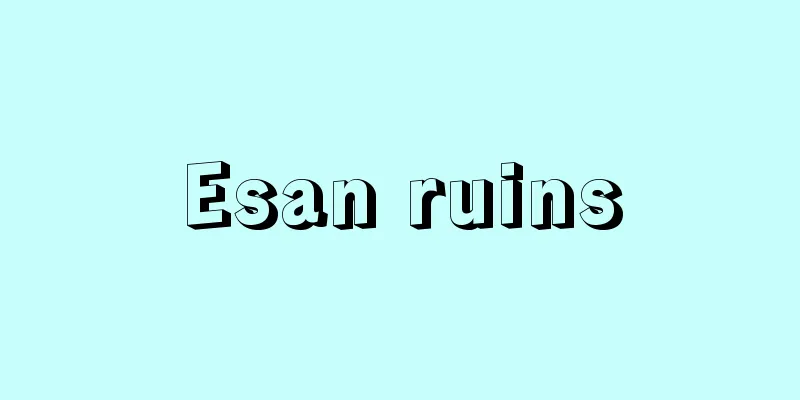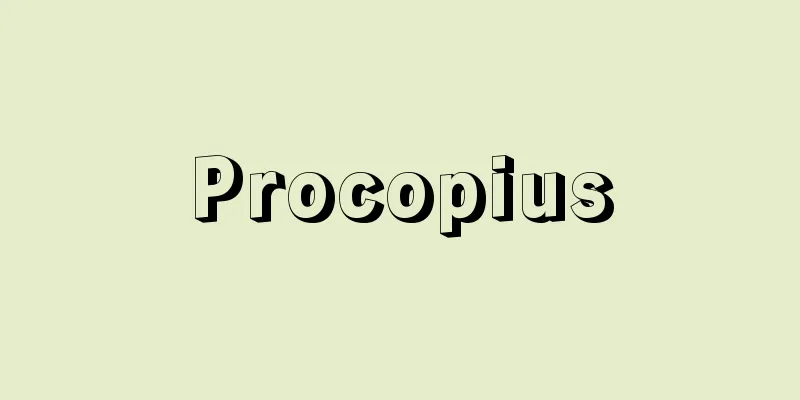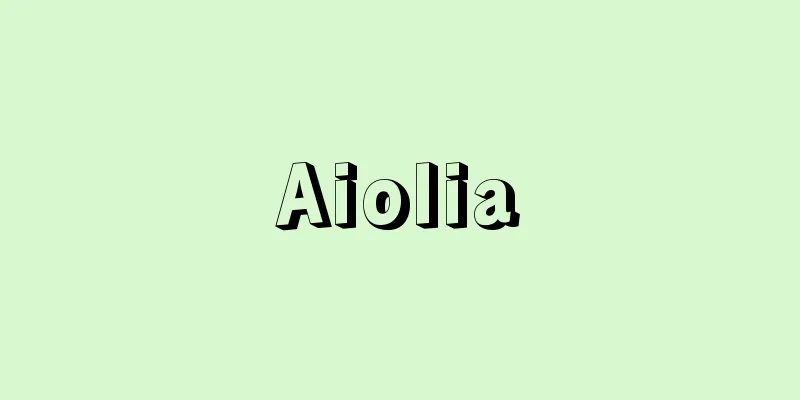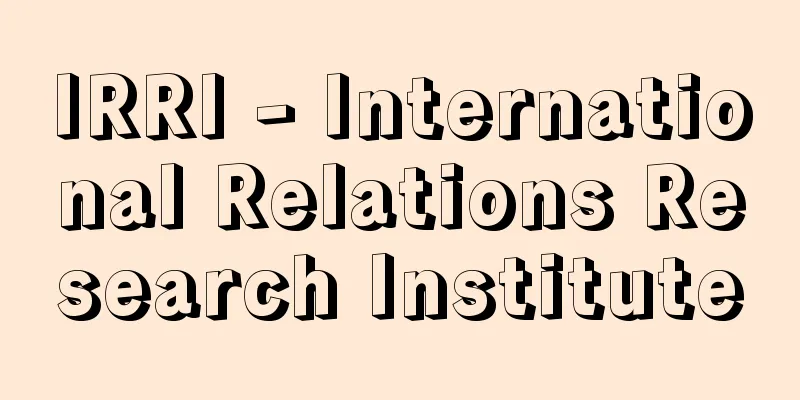In Vitro Fertilization

Biological IVFA form of fertilization in animals. The opposite of internal fertilization. Biologically, it refers to the fusion of egg and sperm (fertilization) that takes place in the water where the animal lives, i.e. outside the body. Fertilization requires that the egg and sperm be placed in the same liquid medium (called insemination, insemination, or assisted spermatozoa), but invertebrates such as sea urchins, sea cucumbers, and lugworms, as well as most bony fish and anuran amphibians, eggs and sperm are released into the water (spawning, spermatozoa), where fertilization occurs. Sperm released into the water retain their ability to fertilize for several hours, but the eggs of fish and frogs lose this ability immediately, so males release sperm onto the eggs at the same time as they are laid. [Masayuki Uchibori] Human IVF/Embryo TransferIn vitro fertilization-embryo transfer (IVF-ET) is a procedure in which adjusted sperm are injected (insemination) into a culture solution containing eggs extracted from the body, causing fertilization, and the dividing embryo is transferred into the uterine cavity through the vagina. It is a treatment for infertility in which fertilization in the fallopian tubes is not possible. In 1978, the world's first successful pregnancy and birth case was reported after in vitro fertilization (IVF-ET), followed by a successful case of embryo freezing and thawing in 1983, and then a successful case of intracytoplasmic sperm injection (ICSI, a type of intracytoplasmic sperm injection) in 1992. These medical techniques are collectively called assisted reproductive technology (ART). Advances in ART have made it possible to preserve surplus embryos by freezing, improving the safety and versatility of treatment, and enabling treatment for couples with severe male factor disorders and fertility disorders, resulting in an increase in the number of patients eligible for treatment. The background to this is the trend toward later marriage and an increase in the age of first childbirth due to women's advancement in society and changes in lifestyle. [Yasunori Yoshimura April 17, 2015] Indications [1] IVF-ET IVF-ET is an absolute indication for cases of bilateral tubal blockage. Even in cases of unilateral tubal blockage, it is a relative indication if severe adhesions or deformations are suspected, such as after endometriosis or pelvic peritonitis. IVF-ET is also indicated for male infertility in which hormone therapy for the husband, varicocele surgery, and spousal artificial insemination are ineffective. For cases of unexplained infertility where no obvious abnormalities are found in a series of infertility tests, timing guidance and artificial insemination are first performed, and then IVF-ET is often performed. In addition, the pregnancy rate of IVF-ET in women over 43 years old is significantly lower than that of younger women, so early IVF-ET is recommended for older women. [2] ICSI Nowadays, even if there are no sperm in the semen, pregnancy is possible using ICSI if there is a very small amount of sperm in the testes. Testicular sperm extraction (TESE) is performed by extracting testicular tissue and retrieving sperm. However, this method has a low sperm retrieval rate, and the testicular tissue that is extracted is large, which causes damage to the testes, so a method of retrieving sperm from testicular sperm using a microscope (microdissection testicular sperm extraction (MD-TESE)) has been developed. [Yasunori Yoshimura April 17, 2015] Ovarian stimulationIn IVF, controlled ovarian stimulation is usually performed to induce multiple follicles and suppress the endogenous LH surge that causes ovulation (the phenomenon in which a large amount of luteinizing hormone (LH) is released from the pituitary gland during ovulation). To induce multiple follicles, ovulation-inducing drugs such as gonadotropin preparations, clomiphene, or a combination of both are used, while gonadotropin releasing hormone (GnRH) agonists (nasal sprays) or GnRH antagonists (injections) are used to suppress the LH surge. Both drugs are used to prevent eggs grown with ovulation-inducing drugs from ovulating naturally before egg retrieval. Since 2010, low-stimulation methods that approximate the natural cycle have been used more often. [1] GnRH agonist method [2] GnRH antagonist method: The ovaries are stimulated with gonadotropin preparations, and in the mid-follicular phase when the follicles reach about 14 mm in size, a GnRH antagonist is started to suppress the LH surge. Since estrogen (female hormone) may decrease after the antagonist is started, the dose of gonadotropin is increased appropriately. [3] Low-stimulation method: If there is no response to normal ovarian stimulation or if ovarian function is impaired, low-stimulation method is selected. Clomiphene alone or gonadotropin injections are added while administering clomiphene. Ovulation is induced when the follicle reaches 18 mm or more. This method is widely used as an ovarian stimulation method for elderly people. [Yasunori Yoshimura April 17, 2015] Egg collection and sperm preparationUnder intravenous anesthesia, eggs are collected using a transvaginal ultrasound diagnostic device. Previously, egg collection was performed using a laparoscopic technique, but since the late 1980s, most egg collections have been performed transvaginally. Follicular fluid is aspirated efficiently with a minimal number of punctures, and the eggs contained within it are collected. Puncturing the ovaries multiple times increases the risk of bleeding, and moving the puncture needle significantly within the ovary can cause lacerations. Complications from egg collection include ovarian bleeding due to puncture, bleeding from the vaginal wall, damage to the intestines, bladder, and pelvic organs, infection, and abscesses. The currently used sperm preparation methods are the swim-up method, the Percoll density gradient method, and a combination of both. Before and after sperm preparation, basic sperm evaluations such as total sperm concentration and motile sperm concentration are performed. In the swim-up method, culture medium is layered over semen or washed sperm and left to stand in the culture medium for 30 to 60 minutes. Sperm with good motility swim up into the culture medium, which are then collected, washed, and used for insemination. The Percoll density gradient method uses the density gradient carrier Percoll (particles of colloidal silica coated with polyvinylpyrrolidone) to separate high-density mature sperm. There is also a method in which mature sperm are collected using the Percoll density gradient method, then the sperm are allowed to swim up, and sperm with good motility are selected and used for insemination. [Yasunori Yoshimura April 17, 2015] Insemination and embryo cultureThe sperm concentration at the time of insemination is adjusted so that the sperm concentration in the culture medium is 100,000 to 400,000/mL. If the sperm concentration is low, fertilization may not occur, while a high sperm concentration can lead to a deterioration of the culture environment and a higher rate of polyspermy. Culture is generally performed in an incubator at 37°C, 5% O2 , and 5-6% CO2 . After insemination, the sperm and eggs are usually cultured together in the insemination medium for 17-20 hours until fertilization is confirmed, and fertilization is confirmed by checking the presence of male and female pronuclei and the release of the second polar body. In the past, embryos were often cultured for 48 to 72 hours after insemination until they reached the stage of 4 to 8 early embryos, but advances in in vitro culture techniques for human embryos have made it possible to culture them for long periods of time. Currently, in order to evaluate the quality of the embryos, they are often cultured for 5 to 6 days until they reach the stage of blastocysts before implantation. [Yasunori Yoshimura April 17, 2015] Embryo transfer and luteal supportThere are two types of embryo transfer: fresh embryo transfer, which is performed two to five days after egg retrieval, and frozen-thawed embryo transfer, in which a frozen embryo is thawed and transferred. The pregnancy rate per embryo transfer is higher with frozen-thawed embryo transfer, and all embryos with good morphology that were not transferred are frozen and stored. If pregnancy occurs after a fresh embryo transfer, ovarian hyperstimulation syndrome may occur. For this reason, since 2000, there has been an increase in cases where fresh embryo transfer is not performed, and instead all embryos are frozen and stored, followed by the transfer of one frozen-thawed embryo. When thawing frozen embryos and transferring them into the endometrium, it is necessary to synchronize the stage of the embryo with the endometrium at the time of transfer. There are two types of transfer cycles: natural cycles and hormonal cycles in which estrogen and progesterone are used to regulate the endometrium. When transferring in a natural cycle, the day of ovulation is confirmed by measuring the follicle size and LH levels in the blood or urine, and transfer is performed two days after ovulation for 4-cell embryos, three days after ovulation for 8-cell embryos, and five days after ovulation for blastocysts. Luteal insufficiency is likely to occur during ovarian stimulation cycles in ART, so luteal activation or progesterone replacement therapy is used after embryo transfer. Human chorionic gonadotropin (HCG) is used for luteal activation. 5,000 units of HCG are injected two days after egg retrieval. Progesterone replacement is done by intramuscular injection, vaginal suppository, or oral administration. [Yasunori Yoshimura April 17, 2015] Treatment resultsAs of 2012, of the 37,953 children born in Japan through assisted reproductive technology (ART) in the past year, 27,715 were born through treatment using frozen embryos. More than two-thirds of the children were born from frozen embryos. The proportion of frozen embryos in Japan's total births has exceeded 1% since 1999, and is now approaching 3.66%, on par with Europe and the US, meaning that one in every 27 children is born through frozen embryos. To date, more than 5 million people worldwide have been born through ART, with approximately 340,000 in Japan. [Yasunori Yoshimura April 17, 2015] For legal issues regarding artificial insemination (artificial insemination and in vitro fertilization), please see the "Artificial insemination" entry. [Editorial Department] [Reference] | | | | |Source: Shogakukan Encyclopedia Nipponica About Encyclopedia Nipponica Information | Legend |
生物学上の体外受精動物における受精の一様式。体内受精の対語。生物学上は、卵と精子の融合(受精)が、その動物がすむ、すなわち体外にある水中で行われることをいう。受精のためには卵と精子が同じ液体の媒質中に置かれること(媒精、授精または助精という)が必要であるが、ウニ、ナマコ、ゴカイなどの無脊椎(むせきつい)動物、大多数の硬骨魚類、無尾両生類では卵や精子を水中に放ち(放卵、放精)、そこで受精がおこる。水中に出された精子は数時間は受精能力を失わないが、魚やカエルの卵はすぐその能力を失うので、雄は産卵と同時にその上に精子を放出する。 [内堀雅行] ヒトの場合の体外受精・胚移植体外受精・胚(はい)移植(in vitro fertilization-embryo transfer:IVF-ET)とは、体外に取り出した卵子の入った培養液に調整した精子を注入(媒精)し受精させる操作であり、分割胚を腟(ちつ)を通して子宮腔(くう)内に移植することである。卵管内での受精が不可能な不妊症に対する治療法である。 1978年に世界初のヒト体外受精(IVF-ET)での妊娠・出産成功例が報告され、その後1983年に胚の凍結・融解での成功例が、さらに1992年に卵細胞質内精子注入法(intracytoplasmic sperm injection:ICSI、顕微授精の一種)での成功例が報告された。これらの医療技術は、生殖補助医療(assisted reproductive technology:ART)と総称される。ARTの進歩に伴い、凍結による余剰胚の保存が可能となり、治療の安全性や汎用(はんよう)性が向上し、また重症の男性因子や受精障害のカップルへの治療が可能になった結果、治療対象の患者が増加してきている。その背景には、女性の社会進出やライフスタイルの変化がもたらす晩婚化、および初産年齢の上昇がある。 [吉村泰典 2015年4月17日] 適応〔1〕IVF-ET 両側卵管閉塞(へいそく)の場合にはIVF-ETが絶対適応となる。また片側の卵管閉塞の場合でも、子宮内膜症や骨盤腹膜炎後など高度の癒着や変形が疑われる場合には相対的な適応となる。夫に対するホルモン療法、精索静脈瘤(りゅう)手術、配偶者間人工授精が無効な男性不妊症もIVF-ETの適応となる。一連の不妊検査で明らかな異常が認められない原因不明不妊に対して、まずはタイミング指導や人工授精が行われ、その後IVF-ETに移行することが多い。また43歳以上の女性におけるIVF-ETの妊娠率は、より若年の女性と比較して大きく低下することから、高齢女性に対しては早めのIVF-ETが提案される。 〔2〕ICSI 現在では精液中に精子がなくても精巣内にごく少量の精子があれば、ICSIを用いて妊娠が可能である。精巣組織を採取して、精子を回収する精巣内精子回収法(testicular sperm extraction:TESE)が行われる。しかしこの方法では、精子回収率が低く、また採取する精巣組織が大きく、精巣に障害を与えるため、顕微鏡を用いた精巣内精子回収法(microdissection testicular sperm extraction:MD-TESE)が開発されている。 [吉村泰典 2015年4月17日] 卵巣刺激法体外受精では通常、複数の卵胞発育と、排卵を起こす内因性のLHサージ(脳の下垂体から、排卵時に黄体形成ホルモンluteinizing hormone(LH)が大量に放出される現象)抑制を目的とした調節卵巣刺激が行われる。複数の卵胞発育には、排卵誘発剤であるゴナドトロピン製剤、クロミフェンあるいは両者の併用が用いられ、LHサージの抑制には、gonadotropin releasing hormone(GnRH)アゴニスト(点鼻薬)またはGnRHアンタゴニスト(注射剤)が用いられる。両者とも、排卵誘発剤で育てた卵子が、採卵の前に自然排卵するのを防ぐ薬である。2010年以降では自然周期に近い低刺激法が用いられることが多くなっている。 〔1〕GnRHアゴニスト法 〔2〕GnRHアンタゴニスト法 〔3〕低刺激法 [吉村泰典 2015年4月17日] 採卵と精子調整法静脈麻酔下、経腟超音波診断装置で採卵する。以前は腹腟鏡下で採卵が行われていたが、1980年代後半より経腟採卵がほとんどである。少ない穿刺(せんし)回数で効率的に卵胞液を吸引し、卵胞液中に含まれている卵子を採取する。卵巣を何回も穿刺すると出血のリスクが増加し、穿刺針を卵巣内で大きく動かすと裂傷を生ずることがある。採卵による合併症として穿刺による卵巣出血、腟壁からの出血、腸管や膀胱(ぼうこう)骨盤内臓器の損傷、感染、膿瘍(のうよう)などがある。 精子の調整法として現在用いられているのは、スイムアップswim-up法、パーコールpercoll密度勾配(こうばい)法、および両方をあわせた方法である。精子調整の前後には全精子濃度、運動精子濃度などの基本的な精子評価を行う。スイムアップ法は、精液、または洗浄精子に培養液を重層し、30~60分間培養液の中で静置する。運動性良好な精子が培養液中にスイムアップして(泳ぎ上がって)くるため、これを回収、洗浄し、媒精に供する。パーコール密度勾配法は、密度勾配担体であるパーコール(コロイド状シリカをポリビニールピロリドンでコーティングした粒子)を用い、密度の高い成熟した精子を分離する方法である。またパーコール密度勾配法で成熟精子を回収し、さらにその精子をスイムアップさせ、運動性良好な精子を選別し、媒精に供する方法もある。 [吉村泰典 2015年4月17日] 媒精と胚培養媒精のときの精子濃度は、培養液中の精子濃度が10万~40万/mLになるように調整する。精子濃度が低いと受精しない可能性があり、高いと培養環境の悪化につながり、多精子受精の率も高くなる。一般に37℃、5%O2、5~6%CO2下のインキュベーターで培養する。通常、媒精後受精確認まで17~20時間、精子と卵子をいっしょに媒精用培養液で培養し、雌雄前核の有無や第2極体放出の有無により受精の確認を行う。 以前は媒精後48~72時間、4~8細胞の初期胚までの胚培養が多かったが、ヒト胚の体外培養技術の進歩により、長期培養が可能となってきている。現在では良好な胚を評価するために、着床前の胚盤胞まで5~6日間培養することが多くなっている。 [吉村泰典 2015年4月17日] 胚移植と黄体補充胚移植には、採卵の2~5日後に行う新鮮胚移植と、凍結しておいた胚を融解して移植する凍結融解胚移植がある。胚移植あたりの妊娠率は凍結融解胚移植のほうが高く、移植しなかった形態良好な全部の胚を凍結保存する。新鮮胚移植をし妊娠した場合、卵巣過剰刺激症候群を起こすことがある。このため2000年以降は、新鮮胚移植を行わず、全胚凍結保存後、1個の凍結融解胚を移植するケースが増えてきている。 凍結胚を融解し子宮内膜に移植するときには、移植時に胚のステージと子宮内膜を同期させる必要がある。移植周期には、自然周期とエストロゲン剤とプロゲステロン剤を用いて子宮内膜を調整するホルモン周期とがある。自然周期で移植する場合には、卵胞径と血中あるいは尿中のLH測定により、排卵日を確認し、4細胞期胚なら排卵2日後、8細胞期胚なら排卵3日後、胚盤胞なら排卵5日後に移植を行う。 ARTにおける卵巣刺激周期においては、黄体機能不全が起こりやすく、胚移植後に黄体機能賦活法あるいは黄体ホルモン補充療法が用いられている。黄体機能賦活法として、ヒト絨毛(じゅうもう)性ゴナドトロピン(human chorionic gonadotiopin:HCG)が用いられる。採卵2日後にHCG5000単位を注射する。黄体ホルモン補充法としては、プロゲステロン剤の筋肉注射、腟座剤、内服薬を使用する。 [吉村泰典 2015年4月17日] 治療成績2012年(平成24)現在、日本で1年間に生殖補助医療(ART)で生まれた3万7953人のうち、2万7715人が凍結胚を用いた治療で誕生している。凍結胚で生まれた子どもが3分の2以上を占めている。日本の総出生児数に占める割合は1999年より1%を超え、いまや欧米並みの3.66%と27人に1人の時代になってきている。これまでに全世界で500万人以上、日本では約34万人が、ARTにて誕生している。 [吉村泰典 2015年4月17日] 人工受精(人工授精・体外受精)の法律問題については「人工受精」の項目を参照。 [編集部] [参照項目] | | | | |出典 小学館 日本大百科全書(ニッポニカ)日本大百科全書(ニッポニカ)について 情報 | 凡例 |
<<: The Great Secret of the Great Encyclopedia
>>: External hardness - External hardness
Recommend
Damage - Ison
〘 noun 〙 In the Heian period, the harvest of rice ...
Canzona (English spelling) canzona Italian
The original meaning is "song". In 16th...
Sumihiro Omura
…After Toyotomi Hideyoshi, the Edo Shogunate appo...
West Japan Railway Company - West Japan Railway Company
Established in 1987 with the division and privatiz...
Cornelio Jansen
Dutch Catholic theologian. He studied at the univ...
Casa
...The walls are made of stone or block masonry a...
Kashima Shrine
Located in Miyanaka, Kashima City, Ibaraki Prefec...
Conference diplomatique du Mètre
...That is, the establishment of a permanent comm...
Aster scaber
…[Hiroji Koyama]. . … *Some of the terminology th...
hymnos
…Christian chants, originating from the Greek hym...
Nitella acuminata (English spelling) Nitella acuminata
…[Mitsuo Chihara]. . . *Some of the terminology t...
Words (Words) - Words
The original form of the Japanese word "kotob...
Urošević, V.
...In pre-war Belgrade, poets such as Crnjanski a...
"Beautiful Japan - My Introduction" - Utsukushii Nihon no Watashi
...In 1968, he was awarded the Nobel Prize in Lit...
Revenue tax - shuutokuzei
It is a general term for taxes on goods that indi...









